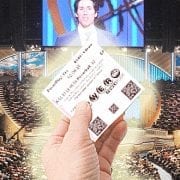Today’s Applied Math Lecture
Today, class, you’re going to learn about the Knaster procedure. The Knaster procedure is often used in certain legal situations, such as divorces or inheritances, where multiple parties wish to divide an asset in a fair and equitable way without liquidating that asset.
Say, for instance, your father passes away suddenly without a will, and among the possessions he leaves behind is his vintage 1968 Mustang with original leather interior. You and your three siblings all agree that the car should stay in the family, so you can’t sell it to an outside party and split the money. However, at the same time, each of you personally wants the automobile. Though, some of you may feel that you’re more deserving of it than others, since you actually spent your Sunday afternoons fixing up the car with dad, while other siblings were out getting high under the bridge and fooling around with Josh Gimley from Jazz Band.
In a case such as this, then, the parties involved would use the Knaster procedure to determine who gets ownership of the car and exactly how much is then owed to the other siblings in exchange. This is done through a method of sealed bids, where each sibling separately assigns a monetary value to the car, based on the amount each believes it to be worth.
In our hypothetical, for example, let’s say that you and your three siblings all submit your bids on the Mustang, and it turns out that you secured the highest bid. Perhaps you just barely edged out one of your older siblings for it. According to the rules of the procedure that you all agreed to, the Mustang is now rightfully yours, despite any grumblings you may hear from your older sister. Gripes like these are very common in familial settings, even when using such a formal method as the Knaster procedure, and when circumstances like these arise, it’s always best to debate and talk matters through rationally. This will preserve the integrity of the procedure.
Your sister may claim, for example, that you inflated your bid beyond what anyone would possibly pay for the automobile. You, perhaps, then counter that you have actually done quite a bit of personal research into classic American sports cars and that your bid is pretty close to the Blue Book value for it. At this point, she may question whether or not you could even afford the amount of your bid, considering you were fired eight months ago. You can then correct her, saying that you were, in fact, laid off from your Assistant Professor position due to routine budget cuts and that you’ve been adjuncting for the last three months, anyway, so maybe you should just shut your mouth about stuff you obviously know nothing about, Carol.
Setting that argument aside, the Knaster procedure now dictates that you and your siblings go about divvying up the value of the estate in a fair and equitable way. Remember, you get the physical car, but you and your three siblings are still each entitled to only one-fourth of the monetary value of it. So, say your total bid for the Mustang was $30,000. In order to provide for an equitable division of the car’s value, you must put three-fourths of that amount, $22,500, into a kitty. Each of the siblings are then entitled to withdraw from the kitty one-fourth of the value that each of them assigned to the car with their own bids.
Note that the kitty is not divided equally between the four siblings. For instance, maybe your older brother only bid $23,000 on the Mustang. In that case, he would be entitled to one-fourth of that amount, or $5750. Now, he might argue that that amount is not enough. However, the system is perfectly fair. After all, these are the rules clearly outlined by the Knaster procedure, and if Frank really wished for more money, perhaps he shouldn’t have bid such an insulting amount on his father’s only parting legacy.
At this point in the process, Carol suggests that we perhaps “forget all this silly math nonsense” and simply “sell the damn thing already.” This is just classic Carol. She would always flip over the Monopoly board whenever I started to beat her. And of course, Susan agrees with her, but she’s been such a bratty little suck up since we were kids, no one takes her seriously, anyway.
Of course, the very foundations of the Knaster procedure rely on all parties accepting its results. So, once again, you and your siblings stop to discuss the matter in a measured and amenable fashion, and after some minutes of deliberation and further attempts at negotiation, finally, the four of you come to some common ground and say, “Well, dammit, Carol, if honoring dad were really so important to you, maybe you could’ve pried yourself away from your precious art gallery for one day to visit him in the hospital.”
I should mention, as a side note, proper implementation of the Knaster procedure can often result in estrangement from one’s immediate family members.
Okay, that concludes the lesson for today. You can find your homework assignment online. For Thursday’s class, we’ll be going over how to calculate the positive predictive value for your ex-wife’s chlamydia test results.
- About the Author
- Latest Posts
Andy Newton is a writer living in Astoria, Queens. His work has been published by National Lampoon and McSweeney’s.














